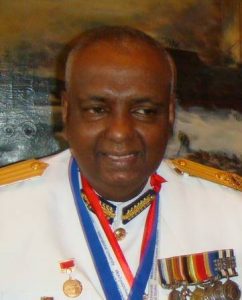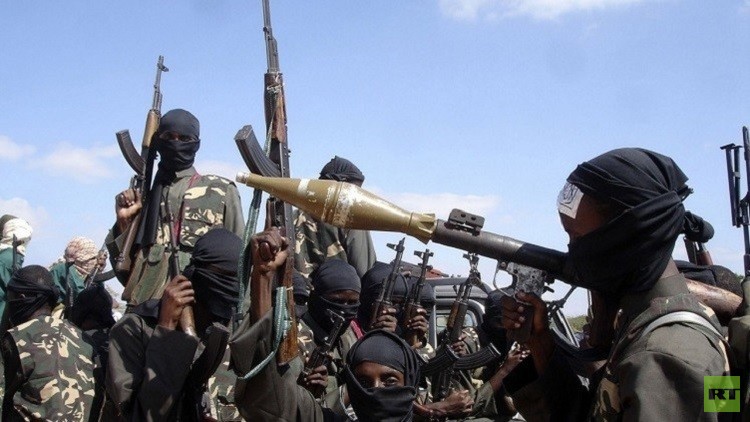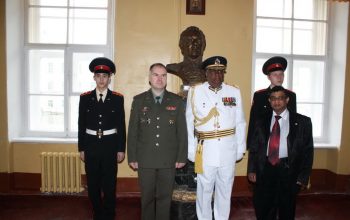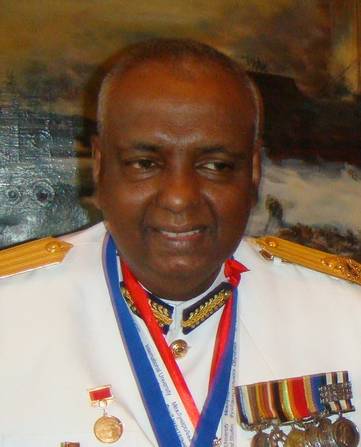
MAHINDA BALASURIYA
Grand D.Sc. Grand Ph.D. M.Phil. B.Sc.
RETIRED INSPECTOR GENERAL OF POLICE
(Chief of Police)
Sri Lanka
Terrorism and Media are inseparable. The future of “Terrorism” totally depend on the international and national, publicity given by the media regarding any terrorist incident soon after it happens. The designed psychological effect expected by the terrorist depend on the magnitude of publicity. If no publicity is given by the media for terrorist acts, “Terrorism” would not have flourished. Media is a catalyzer for terrorism.
Defining Terrorism:
Terrorism has been used in so many ways, to refer to so many different (though often partially overlapping) kinds of acts, that it has become rather blurred in its usage. Even different agencies of the same state have used definitions which are at odds with another. The US State Department, for example has defined terrorism as “Premeditated, politically motivated violence perpetrated against non combatant targets by sub national groups or clandestine agents, usually intended to influence an audience. But the US Federal Bureau of Investigation (FBI) defines it rather differently, as “The use of serious violence against persons or property, or the threat to use such violence, to intimidate or coerce a government, the public, or any section of the public in order to promote political, social or ideological objectives”.
Yet again in 1990, the US Department of Defence described terrorism as “The unlawful use of, or threatened use of force or violence against individuals or property, to coerce and intimidate governments or societies, often to achieve political, religious or ideological objectives”. The variations between these definitions are significant enough to generate a measure of confusion and potentially unhelpful ambiguity.
Professor Bruce Hoffman, has helpfully argued that terrorism involves politically motivated violence or threatened violence, “designed to have far-reaching psychological repercussions beyond the immediate victim or target; carried out by a sub-national or non-state, non-uniformed organization with an identifiable chain of command or conspiratorial cell structure. Terrorism is “the deliberate creation and exploitation of fear through violence or the threat of violence in the pursuit of political change˝. All terrorist acts involve violence or the threat of violence. Terrorism is specifically designed to have far reaching psychological effects beyond the immediate victim (s) or object of the terrorist attack.
It is meant to instill fear within, and thereby intimidate, a wider “target audience” that might include a rival ethnic or religious group, an entire country, a national government or political party, or pubic opinion in general.
Terrorism is designed to create power where there is none or to consolidate power where there is very little. Though the publicity generated by their violence, terrorist seek to obtain the leverage, influence, and power they otherwise lack to effect political change on either a local or an international scale.
It is clearly seen that there exist so many competing and varying definitions of terrorism. “Terrorism is a method which can be used for an infinite variety of goals. Walter Lacquer reports that there are more than a hundred definitions in the literature. How is one to choose among them? One reason terrorism is no difficult to define is that it is often interpreted as a prerogative concept. Whatever the final meaning of the term ought to be those who are identified as terrorists are said to be deserving of blame. Another reason why it is difficult to define “terrorism”, “terrorist”, etc., is that these terms are used in highly emotive settings. We have a pre-definitional sense that they are associated with death, violence, and war.
It should be noted that terrorism is a special case of civil conflict, involving violence by small groups of terrorists who chose specific targets in order to intimidate watching audiences. The performance of acts of terrorism does not require large numbers; hence it is an economical and efficient weapon for the weak groups. Although terrorism does not cause the high number of victims that protracted civil wars do; it outrages and horrifies the public and attracts extensive media courage. In part this disproportionate effect is due to the timing and form of violence, but it is also due to the fact that the victim of terrorism are most often unsuspecting and unprepared civilians rather than the armed forces of the state.
Governments may thus be more reluctant to enter into negotiated settlements with groups using terrorism than with groups employing other means of violence. It is also possible that one reason campaign of terrorism are protracted is because they are not destructive despite their heavy psychological impact. Emotional reactions to terrorism may be momentarily intense.
Many persons are at present quite properly concerned with the threat to constitutionalism, to rights of liberties, by their governments’ reaction to the threat posed by terrorism. Few of us consider, however, that terrorism itself might become a threat to the legitimacy of those states that depend upon the consent of the governed.
The terrorist act and the victim usually have symbolic significance. The stock value of the act is enormously enhanced by the power of the symbol that the target represents. The whole point is for the psychological impact to be greater than the actual physical act. Terrorism is indeed a weapon of the weak.
Terrorist movements are invariably both outmanned and outgunned by their opponents, so they employ tactics in an effort to gain more attention than any objective assessment of their capabilities would suggest that they warrant. Bin Laden, for example, referred to the “Twin Towers” as “Icons” of Americas military and economic power.
Terrorism is a by-product of broader power in all of its forms – political, economic, military, ideological and cultural. These are the same forms of power that characterize the forces of western – led globalization.
Terrorism that threatens international stability, and particularly US global leadership is centered on power-based political causes that are enduring; the weak against the strong, the disenfranchised against the establishment, and the revolutionary against the status quo. Over simplified generalizations about poverty and terrorism or any other single variable are circumstances of a serious argument.
Understanding the Media’s Role:
The media has often been cited in the context of a terrorist incident as another important factor in the modern terrorist’s arsenal. During an attack, a terrorist often benefits from a media “amplification effect”, as terrorist activities are broadcast by the media to a much larger audience than would normally be available. Today’s post modern terrorist has learned a valuable lesson about our world: television and other media can be manipulated as a vital link between the terrorist and the intended audience.
Forging this link requires an act which is “newsworthy” – this has come to outrageous, even barbaric forms of attack. Terrorists accordingly attempt to display “showmanship” in order to get adequate airtime. This nexus of interest between the media who thrive on sensational news and terrorists are only too happy to provide sensational events which has raised questions. Brian Jenkins, a well-known terrorist expert from Kroll Associates, has stated “terrorists want a lot of people watching, and a lot of people listening, not a lot of people dead˝. I consider terrorism as violence for effect. Terrorists choreograph dramatic incidents to achieve maximum publicity and, in that sense, terrorism is a theater”.
If it is understood that terrorists are putting on a show, it becomes easier to understand how they manipulate events to their own satisfaction. The most basic reason for terrorism today is to gain recognition for a particular cause; the best way, to do that is through the media, whose job is to provide a worldwide audience with nearly immediate information.
Publicity is part of the terrorist action itself. The terrorist operation is “propaganda of the dead”. The resonance the terrorists hope to find in the media is calculated. Therefore, government adherence to a firm attitude is made more difficult by the publicity the terrorist expects are which indeed is given to terrorist action in the media.
In the Mumbai attack at “Taj Hotel”, the media had a live telecast for almost two days continuously. This gave very wide international publicity for the terrorists. This action of continued telecast should not have been done by the Indian media. It hampered the national security of India by unnecessary comments about the rescue operations and the general security arrangements to counter terrorist attacks in India. The advantage was to the terrorists but not to the public or to the authorities.
Another similar television story in Israel, which is ironic in many ways because the successful rescue of the hostages in Entebbe relied solely on the secrecy of the operation. The fact that Israeli TV later apologized to the Federal Government showed that again there was some soul – searching alone and that they came to the conclusion that at that point in the development it was very wrong go to public on the air.
Working with the Media:
Emergency response teams in the past have had cameras thrust at them in other emergency situations. Some responders become upset and angry with such crews and refuse to answer questions. Other responders may being talking to the first member of the news media who asks them a question. Both of these responses should be avoided. Responders must be made aware that the media has a right – indeed, an obligation – to report the news to the public. Once responders realize they and the media share similar responsibilities, responder irritation should be minimized.
Incident Phase:
After a terrorist event, the media need facts and accurate information. This is what the public expect. To facilitate this process, response agencies should co-ordinate their efforts and follow these guidelines to provide information as quickly as possible.
- Do not mislead
- Answer all questions truthfully
- Promise to get information
- Become familiar with deadlines
- Do not overstate a problem: and
- Distribute the facts.
At this stage of an incident, expect chaos and confusion yet, these simple rules should allow responders and incident commanders to handle most questions.
Do not forget what may seem to be an oxymoron: journalism ethics of course, some display nothing of the sort, but most journalists have a strong sense of fair play about getting a good story. It is important to establish trust with the media. Learn how errors can be redressed. Agencies and responders should know that some journalists may record interviews. Responders should understand and appreciate the definitions on the record, off the record, background and confidential sources, and the need to compare sources.
Special Problems Encountered when dealing with the Media:
While the media can be an asset, they can also present problems. For example, investigative reporters continue to harrass officials. When dealing with these reporters, never hide problems. Should be completely honest with them within the bounds of agency guidelines. Responders should never answer a question that he or she is not authorized or capable of answering properly. They will only put their own and their agency’s reputation at risk. “No comment” does not put off a good investigative reporter. It is better for responders to talk to the media that an answer is unknown and to then search for the appropriative answer.
Media Competition:
Media competition can have a damaging effect. It is important to remember that every reporter is out to “scoop” the competition. Sometimes even during emergencies, media agencies looking for a scoop might print only half of the story.
How the Media can help:
The media can often be of help by performing certain emergency management functions, such as alerting the public with bulletins or a radio and TV alerts. Print Media can also get large amounts of information to the public. In addition, the media provide data that can be read and reread for clarity:
- Casualty lists
- Condition of the injured
- Investigative reports
- Protective locations
- Shelter locations
- Disaster assistance Centers locations and
- Safety tips.
During an emergency or terrorist incident, the media may rely emergency public information through the Emergency Broadcast System (EBS). This is a system by which emergency managers may formally direct radio and television stations to transmit immediate public warnings.
Dealing with the Media on Scene:
If a particular agency has not already set a media policy, the following will provide some overview of how to deal with the media. Most emergency agencies co-operate with information gathering activities as long as overall rescue operations or investigations are not jeopardized. However, by dealing with a news crew may try to get a shot of operations.
Once it has been determined that the operations may involve interaction with the media, the incident commander should immediately appoint a Public Information Officer (PIO) to deal with all press issues.
The PIO’s duties and responsibilities include relaying the official position of agencies, he or she shall be considered the spokesperson for the operation concerning the following:
- Department policy
- Procedure
- Operation and tactics; and
- Previous and ongoing investigations/incidents
Access to the Emergency Site:
Reporters need to get as close as to the story as possible keep in mind the following rules when treating site access:
- Allow TV and print photographers to get as close to the scene as possible with safety as well as that of emergency personnel;
- Give reporters a tour of the scene.
- Never use danger as all excuse to keep the press away;
- Remember: TV needs pictures immediately.
Allowing the media to enter the scene of a terrorist attack is ultimately the responsibility of the incident commander. If the media is allowed access, the PIO should conduct a safety briefing for them. Most recent news crews have worked in dangerous situations, but do not take their experience for granted. It must be ensured that everyone is aware of the hazards that may be encountered.
Security of Information Vs. The Public Right to know:
Over the past two decades there has been a significant increase in the relationship between the media and terrorism. With the attacks on the world Trade Centre and the Murrah Federal building in Oklahoma city, this fact has been brought to the forefront. Many terrorism experts and media professionals will no doubt continue to debate the issue of the public’s right to know versus the need to keep sensitive information secure.
Peace Journalism (PJ):
Peace Journalism is a broader, and more accurate way of framing stories drawing on the insight of conflict analyzes and transformation.
The PJ approach provides a new road map tracing the connections between journalists, their sources, the stories they cover and the consequences of their reporting – the ethics of journalistic intervention. It opens up a literacy of non-violence and creativity as applied to the practical job of everyday reporting.
A brief history of Peace Journalism:
Johan Galtung, Peace Professor and Director of the TRANSCEND Peace and development network, first began using the term “Peace Journalism” in the 1970’s. Galtung noticed that a great deal of war Journalism was based on the same assumptions as “Sports Journalism”. There was a focus on “Wining as the only thing” in a zero – sum game of two parties.
Working with Galtung himself, conflict and peace forums, based in London, took up his original model and developed it through creative dialogues with Journalists and other professionals, mainly in a series of annual conferences at Taplow Court. Peace Journalism is based on the proposition that decisions Journalists make while covering conflicts tend inescapably to contribute to the momentum towards war or the momentum towards peace.
Communication Theory of Terrorism:
This is a famous theory adopted by the terrorist organizations in the world. In discussions on the purposes of insurgent terrorism and prominent and sometimes even paramount place is reserved by analysts of terrorism to the communication aspect. Martha Crenshaw, for instance writes; “The most basic reason for terrorism is to gain recognition or attention”. The role of the media is vital here. J. Bowyer Bell also sees the advertising function of terrorism as the most important one. In the same vein Francis M. Watson holds that terrorism must not be defined only in terms of violence, but also in terms of propaganda. The two are both in operation together.
Another revolutionary theorist, the German – American Johan most, put it more explicitly.
“Everyone now knows, that more perfectly executed the attempt, the greater the propagandistic effect.” Further in 1960’s the Brazilian Carlos Marighela reinvented the “Armed Propaganda” and the symbolic use of violence as a means of communication and recommend it in his Mini-Manual of the Urban Guerrilla.
Martha Crenshaw also stresses the role of violence as communication to various audiences, without giving up terrorism as revolution model. She quotes for instance, one revolutionary leader, Ramadare Abane, as saying; “We must have blood in the headlines of all newspapers”. One behavioural expert, the Australian – American psychiatrist F.Hacker, put the role of mass communication as a casual agent especially high. Offering the suggestion; “If one could cut out publicity, I would say you could cut out 75% of the national and international terrorism”.
Terrorism and Propaganda:
Propaganda is defined by the North Atlantic Alliance as any information, ideas, doctrines or special appeals disseminated to influence the opinion, emotions, attitudes or behaviour of any specified group in order to benefit the sponsor either directly or indirectly. Propaganda and terrorism are identical as they both seek to influence a mass audience in a way that is intended to benefit the sponsor. But while terror has a singular purpose – including fear and uncertainty – propaganda can and does same way imaginable purpose from religion to politics to commerce. Indeed, terror might be seen a sub-species of propaganda. Yet, terrorism is also a sub-species of revolution, which is a struggle for power.
Theorist Hazan suggests that propaganda must first attract an audience attention by penetrating the “Absorption screen”, a relatively easy task, and that, to be effective, it must then penetrate the “Personality Screen”. During the latter process the beliefs, values, attitudes, concepts, expectations etc., of individuals in the audience relate to the propaganda message, simply, clarity and label it and produce an opinion. The individual acts has been influenced by the message and not because of his previous views. Eventually his personality is changed.
Television appearances by terrorist leaders and spokesman also provide occasions for justification. On this medium, the “presence” of the speaker influences audiences more than his or her words. This to the great advantage of the terrorists if propaganda is half the terrorist’s armoury, and perhaps the decisive half in terms of survival, there is surely a strong base for government counter-terrorist measures to contain a psychological component. The problem, of course, is public opinion at any form of propaganda, and politician’s consequent unwillingness to touch the subject.
Conclusion:
Terrorism and media are interconnected and survival of terrorism is dependant of media. The “amplification effect” of the media is the key factor. If no national and international publicity is gained by an act of terrorism, the incident or the attack will go unnoticed. Then the terrorist do not achieve the desired goal.
The public has a right to know about any terrorist attack. It is the responsibility of the media to educate the public. Role of the media is vital in emergency management after a terrorist attack. The public expect the assistance of the media immediately to get information about casualties and dead persons. In this regard media plays a key role. But at times the media provides information regarding wanted suspects and regarding counter terrorist operations and regarding the progress of investigations. This is very counter productive. Also the false propaganda at times alarms the public. This too is counter productive. As a result operation and investigations are hampered to a great extent.
But it will be the responsibility of government authorities, specially the Police to provide quick and accurate information to the media other than secret information. If this is not done the media is compelled to gather information from other sources and to publish which might mislead the public. This is a very unsatisfactory situation.
Electronic media and the printed media is the link between the terrorist and the public. Therefore, the media has a great obligation to maintain a balance. This could be done by truthful and quick media reporting only, A.F.Hanker has commented, “If one could cut out publicity, it could cut out 75% of the national and internationalism”. Then the respective governments could fight to end terrorism more easily.
However it is, the media has a right and an obligation to the public to report about terrorist incidents. The government authorities also should co-operate with the media when reporting terrorist incidents. But the media should not act as a catalyzer and should not facilitate and promote terrorism when reporting terrorist incidents.
References:1
- Terrorism – The new world disorder by Nicholas Fatin, Boris Koshinko and Jaanne K.Lekee (2008)
- Terrorism – How to Respond, by Richard English. (2006)
- What Terrorist Want – Understanding the Terrorist Threat by Louse Richardson (2005)
- Terror and Consent by Philip Bobbitt.
- Contemporary Research on Terrorism, by Paul Wilkinson and A.M.Stewart (1987)
- Peace Journalism by Annabel McHoldirick (2006)
- Political Terrorism by Alex P. Schimid (1984)
- Defeating Terrorism by Russel D.Howard (Colonel US Army, Reid L.Sawyer Major US Army) – (2003)
- Counter Terrorism by Christopher Kozlow (1997)



